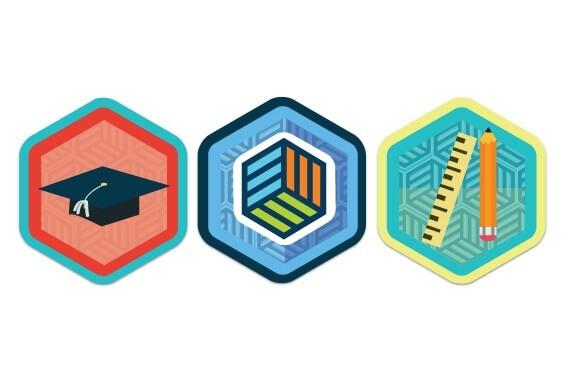6 Benefits of Incorporating Open Badges into your LMS
Shauna Carson
Gamification is a popular trend in eLearning today - that is, the awarding of points and badges based on the completion of different learning activities. Open Badges are becoming a more widely used achievement tool, particularly in online learning. After all, shouldn't all learning be recognized, regardless of where it takes place?
In this blog post I'll be talking about what Open Badges are, reveal 6 benefits of incorporating Open Badges into your LMS and explain how Open Badges work in our SkillBuilder® LMS learning platform.
What are Open Badges?
Within the eLearning industry, there is inherent value in recognizing the achievements and successes of learners wherever learning happens because it increases learner motivation, makes learning more fun and adds a new dimension to learning in the workplace.
To help accomplish this, Mozilla created Open Badges in 2011 and, today, millions of Open Badges have been issued to learners around the world. But, what exactly are Open Badges?
Open Badges are:
"Verifiable, portable digital badges with embedded metadata about skills and achievements. Each Open Badge is associated with an image and information about the badge, its recipient, the issuer, and any supporting evidence. All this evidence may be packaged within a badge image file that can be displayed via online CVs and social networks".
Open Badges allow learners to earn badges, then be recognized for that achievement not only by the issuing organization, but also via the social platforms that matter to them. The data in these badges can be accessed by other companies or shared on social media. Learners can, in effect, get recognition for learning that happens anywhere. Learners have complete control to display their badges wherever they choose - on LinkedIn, Facebook, Twitter, etc. They can also include their earned badges on their resume or email them to a potential employer as proof of their credentials.
There are four components to the Open Badge:
- Earn - learners can earn Open Badges for skills they've acquired online and in person.
- Issue - anyone can create and issue Open Badges to recognize the achievements of learners.
- Display - learners can share their Open Badges as verifiable records of learning.
- Understand - issuers provide portable and verifiable information about skills and achievements.
Open Badges represent "legitimate, authenticated achievements, described within the badge and linked to the awarding organization". They are embedded with metadata about your skills and achievements, including:
- Hard skills, such as proficiency in a programming language
- Soft skills, like collaboration
- Official certification
- New skills and literacies not recognized by traditional education providers
Open Badges can be earned from over 3,000 organizations around the world, and now learners can earn badges by completing learning activities in SkillBuilder® LMS. Within the application, administrators can create, set up and align Open Badges with individualized learning paths.
6 Benefits of Incorporating Open Badges into your LMS
1. Open Badges are transferable: Earning a badge is great, but they only do so much good if they exist solely on the site where they were obtained. Today's learning management systems should allow learners to store and post all their learning achievements and be recognized for them by their employer, regardless of where learning took place. Open Badges are tangible recognition items that can be hosted in various places.
2. Open Badges are recognizable and verifiable: Regardless of where an Open Badge is earned, they are a recognized standard in online learning today. What is unique is that these portable image files contain metadata with the credential you've earned - evidence of your abilities, as well as information on the issuing organization that anyone can verify. This data can be viewed when the learner displays and shares their badge.
Verifiable information includes:
- Details about the issuing organization
- What the individual did to earn the badge
- The criteria by which learners were assessed to achieve the badge
- That the badge was issued to the correct recipient
- When the badge was issued and whether it expires
3. Open Badges are credible: Where information on a resume is a description of a potential employee's knowledge or skills, an Open Badge is the proof or evidence that he/she has that particular skill. Earned badges can be authenticated. Learners access their earned badges from their backpacks; anyone can open the badge and know it's credible.
4. Open Badges are secure: The security around open badges is very high as they cannot be tampered with. Because badges are secure and authentic, external vendors can provide badges that are verifiable, that can be reported on, and that prove the recipient of the badge is competent.
5. Open Badges can promote your brand: Badges can be shared across your organization as well as across your entire business ecosystem, carrying your brand and its values with them. Consequently, more people will recognize your investment in learning and the value you place on learning in your organization.
6. Open Badges can help build your community: Each of your badges links back to you regardless of where they are shared or used. This helps to develop your reputation as the issuer.
How Open Badges Work in SkillBuilder® LMS
Open Badges can be earned from many organizations around the world. Learners use backpacks to store and share their badges. Mozilla Backpack, for example, collects, manages, and displays badges from multiple sources anywhere on the web. SkillBuilder® LMS also has a built-in backpack feature for learners to use. In SkillBuilder®, badges are associated with learning paths, meaning that administrators can create, set up and issue Open Badges for any of their learning paths. Learners can save their badges to their dashboard, in their backpack, email them to anyone, or share them on social media sites.
Why use SkillBuilder® LMS for Open Badges?
- Setting up badges within the application is intuitive, and easy to follow instructions are provided.
- Open Badges can be associated with any learning path you choose.
- Badges can be created in all languages supported by the application.
- Administrators can upload Open Badges received from external vendors.
- When uploading a badge from an external vendor, SkillBuilder LMS automatically verifies that the badge is valid and that the learner has indeed earned the badge.
- SkillBuilder LMS validates badges frequently and identifies when a badge has expired or been revoked.
- SkillBuilder LMS has a built-in backpack where learners can store all the badges they've earned both from within your organization as well as from external organizations.
- Learners can easily share their badges from their backpacks on social media platforms.
- In addition to sharing badges through social media, learners can download any valid badge they have in their backpack and save it to their computers as a .png file to be uploaded to other backpacks such as OpenBadgePassport.
- Learners can delete external badges that they have earned but no longer want to show in their backpack.
The SkillBuilder® LMS team can also help you create a series of badges that align with the look and feel of your organization and brand.
Conclusion
This article introduced you to Open Badges and identified the benefits of incorporating them into a learning management system. It also discussed how Open Badges work in SkillBuilder® LMS.
Do you want to reward learning in your organization by offering Open Badges? Create your learning portal today at no cost.
Free eBook
Six Ways to Leverage SkillBuilder® LMS
Learn how our LMS’s functionality can improve your training program!
TopicsChoose Topic
📘 Ready to Elevate Your Learning Strategy?
Explore our comprehensive library of eBooks and tools on learning resource development, competency-based learning, and LMS implementation. Transform your training programs with insights from industry experts and practical templates.
Shauna Carson
Shauna graduated from the University of Toronto in 2002 with a Master of Arts in English before moving home to Calgary to work in the fast-paced, detail-oriented oil and gas industry. Now certified as a technical writer, Shauna is comfortable writing in a variety of styles, and for a variety of audiences.

